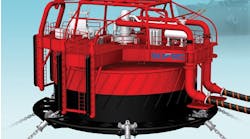Mad Dog to adopt North Sea standards for living quarters
Victor Schmidt
Exploration Editor
As a designer and builder of offshore accommodation units, the Emtunga division of Pharmadule Emtunga built its business largely on North Sea activity. The company decided in 1998 to seek more work beyond the North Sea oil theater in the world's other petroleum regions.
Earlier successful projects in the Caspian Sea, such as the Chirag field for BP-AIOC, opened the way for additional work and new business contacts. Successful contracts followed in Africa and Southeast Asia, in addition to continued activity in its traditional North Sea region. Klas Wallin, vice president for Emtunga, credits the company's success to its high quality construction standards and skilled workforce. These, combined with large production capacity, exceed the capabilities of most shipyards to produce durable accommodation modules.
Most oilfield accommodation facilities must be designed for a service life of at least 30 years, while ship modules are usually designed for 15 years. The longer lifetimes of oilfield accommodation units demand tighter construction controls and the best materials. Demo-graphic changes in the offshore workforce and the need to retain skilled workers have led operators to build more space and comfort into new accommodation, compared with units built early in the North Sea's oil history.
Caspian and Indonesian activity
In November 2001, Emtunga installed the living quarters for Okioc, a man-made island facility in 5-m water depth in the Caspian Sea off Kazakhstan for the Kashagan development. To deliver materials to the Caspian, the modules were optimized for the shipping limitations of the Volga/Don River and lock system. The maximum size for the locks is 100 m long by 16 m wide. Once the quarters were transferred to Agip-KCA, the Kashagan operator, discussions started over expansion of the program using barges, which would be grouted to the island adjacent to the new facilities.
The Caspian Sea has strict environmental regulations including discharge purity and temperature limits. Emtunga will provide all the power, heating, ventilation and air conditioning, water handling, and water treatment facilities for these installations. Each barge accommodation unit will service 130 people. All water must be fully treated and temperature controlled to within 3° C of the Caspian's temperature before discharge. All trash and solids will be burned, with the residue shipped to shore for disposal.
Bruces Shipyard of Landskrona, Sweden, will build the two steel-hulled barges with four-point mooring systems and winches. The hulls will have a 1.5-m draft under normal operation, but will have sponsons added to reduce the draft to 1 m for the shallow Caspian. Tow-out of the barges is scheduled for September 2002 with arrival in October. Final installation will take place over the winter in time for service in April-May 2003.
Facilities development continues at Chirag field under the operatorship of BP and AIOC. Emtunga is working on one 140-person accommodation unit for a platform under development. The unit will be ready for shipment in spring 2003 for assembly to the deck frame in Baku before being moved to the field. Negotia-tions are continuing for the delivery of two more identical additional accom- modation units.
In April, Emtunga completed the 86-person accommodation unit for Unocal's West Seno floating storage unit. The modular units were shipped to Batam Indonesia for hook-up and additional steelwork by subcontractor Nippon Steel, which added a helideck, base frame, external towers, and gangways. Hook-up of the units was completed in May and commissioned for a late June delivery before installation on the hull.
North Sea technique shift
In the Norwegian North Sea, the company successfully delivered the Ringhorne accommodation unit in August 2001. This is a 1,300-ton facility that after delivery was redesigned for an offshore lift. Following this assignment, the company won the Norsk Hydro Grane accommodation unit from Kværner, the project coordinator.
This 110-man unit marks a shift in industry thinking away from large-weight lifts to smaller modular lifts using available construction site cranes. The Grane accommodation modules will be assembled in a Stavanger yard where the cranes have a maximum 60-ton lift limit. This entails four- or six-room blocks being lifted and assembled sequentially to form the accommodation unit.
This mode of construction is possible because of the split in construction activity from one end of the platform being built to the other. The more dangerous activities are centered around the drilling and process package on one end of the platform, while the accommodation units are on the other end away from volatile fluids and high-pressure equipment. It means that a smaller accommodation assembly crew can be used in the shipyard, even if they work longer to complete the job. Also, available personnel can do much of the work without the need for specialized assembly crews. This saves significant amounts of money and lowers the cost of development for smaller fields.
Recently, Emtunga was awarded the $12-million contract to build a 126-person accommodation unit for BP's Mad Dog project. Engineering and construction is already under way in Gothenburg. This marks the company's entry into the Gulf of Mexico. It is also significant, as it proves the company can comply with the US Coast Guard's strict regulations concerning deepwater facilities and can also cope with the high US parts content required to ease long-term maintenance.
Kristin EPC
Emtunga also has a letter of intent for the Prosafe Safe Scandinavia rebuild program (250-beds extension to support the Grane field hook-up program in the North Sea), and it has a firm order, worth NKr 240 million, for the living quarters for Statoil's Kristin development in the Norwegian Sea. The workscope comprises engineering, procurement and construction of the quarters, helideck and control room. The unit, with a floor area of 3,600 sq m, will incorporate 104 berths in single cabins and should be installed on the platform by 2Q 2004.
Emtunga continues to seek additional projects in other regions. In the Caspian, the Chirag field will need more platforms and accommodation units for personnel. Off Germany, the Mittelplatte man-made island needs a replacement accommodation unit, while in the Dutch sector, the Wintershall F/16 platform requires an 80-90-person unit.
null





